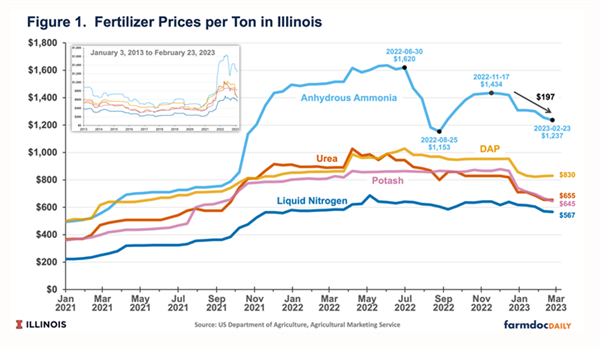
These large fluctuations have been largely due to changes in trade flows with Russia because of the tensions in the region, sanctions imposed on Russia, inflation, and other pandemic-related complications with transportation logistics. Collectively, expensive fertilizer prices have been a challenge globally and certainly in our crop production systems of the desert Southwest.
Recently, several retail fertilizers have varied significantly in the market trends. For example, in May 2023 about half of the major retail fertilizers are higher compared to April prices and the other half has lower prices than last month (Quinn, 2023).
Urea (46-0-0) has gone up 6% in retail markets since last month with an average price of $664/ton. A few weeks ago, urea was below $600/ton for the first time since late 2021. Similarly, diammonium phosphate (18-46-0), monoammonium phosphate (11-52-0), and urea ammonium nitrate (32-0-0) had an average the past month of $517/ton.
In contrast, anhydrous ammonia (82-0-0) has had an average price recently of $910/ton, which is down about 9% in price from April 2023. Several other major fertilizers have been lower in price the past month. Muriate of potash (KCl, 0-0-60) had an average price in the past month of $627/ton, ammonium polyphosphate (10-34-0) average price has been $739/ton, and urea ammonium nitrate (UAN-32, 32-0-0) average price has been $423/ton this month.
Note that several of the major fertilizer materials come in different forms. For example, urea ammonium nitrate (UAN) is 28% N in some materials and 32% N in another common form. Also, monoammonium phosphate (MAP) can have N concentrations of 10-12% and P2O5 concentrations of 48-61% with 11-52-0 being probably the most common form in the market.
Considering the overall trends in the past few years, international fertilizer prices have been generally decreasing since the summer of 2022. Today, international fertilizer prices are back in a range close to early 2021. International fertilizer prices are not expected to drop below pre-pandemic levels, primarily due to global inflation that generates an increase in production and transportation costs (Figure 1).
Several expert sources in the fertilizer industry are projecting a drop in international fertilizer prices in the coming months by approximately 50% of the prices experienced last year. Accordingly, many fertilizer importers are waiting to ship to markets and farmers are often waiting and watching for the projected drop in fertilizer prices to materialize before purchasing (Schnitkey et al., 2023).
Despite the high degree of volatility in international fertilizer markets and the limited availability of fertilizers in some crop production sectors that have recently been experienced, it is expected that the downward trends will continue.
Looking ahead, many experts in the international fertilizer industry are recommending for producers to not wait until too late to purchase fertilizers for upcoming crops, utilize economies of scale when purchasing fertilizers materials as much as possible, and of course watch the trends in fertilizer markets. International logistics in the fertilizer industry, including shipping, transfer, and distribution of fertilizer cargo is proving to be very important in realizing a more stable fertilizer market for the future.

Figure 1. Example of fluctuations in fertilizer prices per ton of material from
January 2021 through March 2023. Source: Schnitkey et al. 2023
References:
Schnitkey, G., N. Paulson, C. Zulauf and J. Baltz. 2023. Fertilizer Prices and Company Profits Going into Spring 2023. farmdoc daily (13):36, Department of Agricultural and Consumer Economics, University of Illinois at Urbana-Champaign, 28 February 2023.
Quinn, R. 2023. DTN Retail Fertilizer Trends: Fertilizer prices moving in two directions. DTN Newsletter, 17 May 2023. https://www.dtnpf.com/agriculture/web/ag/crops/article/2023/05/17/fertilizers-moving-two-directions
It’s unfortunately a very great season to be a plant pathologist…
We have confirmed the first sample of Fusarium wilt on lettuce submitted to the Yuma Plant Health Clinic from Yuma County. The stunted seedlings looked like any other typical case of damping-off at the seedling stage. When plated on culture media, subsequently confirmed Fusarium colonies grew abundantly from the declining plant tissues. If you’re not already on guard and scouting, this is a warning that Fusarium is active in Yuma County.
Adding on to this early alert, we’ve received a surge of submissions of young brassicas to the clinic. Several severely wilted and declining plants from around Yuma County have cultured positive for Pythium, likely as an opportunistic invader coming in on the back of all the early-season rain that brought stress to seeds and young transplants. Growers may want to consider oomycides, but only if the seedling disease is first confirmed to be Pythium. Remember, many seedling diseases caused by true fungi are indistinguishable from those caused by Pythium.
If you have any concerns regarding the health of your plants/crops please consider submitting samples to the Yuma Plant Health Clinic for diagnostic service or booking a field visit with me:
Chris Detranaltes
Cooperative Extension – Yuma County
Email: cdetranaltes@arizona.edu
Cell: 602-689-7328
6425 W 8th St Yuma, Arizona 85364 – Room 109
Interested in the latest developments in automated weeding machines? There are a couple of opportunities at the upcoming 2023 Southwest Ag Summit to stay up to date. The first is the “Innovations in Weed Control Technologies” breakout session where university experts and cutting-edge innovators will provide updates on the latest advances in high precision smart spot sprayers, autonomous ag robots and towed automated weeders (agenda below). The session will be held Thursday, February 23rd from 9:30-11:30 am at Arizona Western College (AWC) in Yuma, AZ. The other is the Southwest Ag Summit Field Demo on February 22nd, where several of these technologies and other state-of-the-art automated weeders will be demonstrated operating in the field. The Field Demos will also be held at AWC and begin at 10:30 am.
For more information about the Southwest Ag Summit, visit https://yumafreshveg.com/southwest-ag-summit/. Please note that at the time of this writing, the website has some incorrect dates and programming information. It will be updated soon, so please check back for accurate information. The flyer below has the correct dates (Fig. 2).

Fig. 1. Agenda for the “Innovations in Weed Control Technologies” educational
session at the 2023 Southwest Ag Summit. Session will be held Thursday,
February 23th at Arizona Western College, Yuma, AZ.

Fig. 2. 2023 Southwest Ag Summit flyer. Event will be held at Arizona
Western College in Yuma, AZ.
We published this booklet last July. Please let us know what you think by responding our five questions in the link provided below. The first 25 respondents WILL RECEIVE a copy of the guide. Additionally…first five to take the survey and ID the weeds in the cover of the booklet will also get a Navy Blue UA Vegetable IPM HAT.
There are abundant resources for weed identification of mature plants. These include very complete guides such as “Weeds of California and Other Western States” by Joseph DiTomaso published by University of California. “An Illustrated Guide to Arizona Weeds” by Kittie F. Parker with excellent drawings by Lucretia Breazeale Hamilton. There are also several phone apps for weed identification. However, the cotyledons of weeds frequently have a different shape than the true leaves, which makes identification of seedlings difficult for some species. The purpose of this pocket booklet is to provide a quick reference with good images that can be carried in your truck to help you identify the most common broadleaved weeds in Southwestern and Central Arizona.
The method for identification presented is not by using a dichotomous key or answering complicated questions about the species. The idea is to leaf through the booklet and find images that match plants you see in the field. If there are unusual characteristics, we note them in our comments for each weed. Here is a link to the guide in PDF format: HERE
This time of year, John would often highlight Lepidopteran pests in the field and remind us of the importance of rotating insecticide modes of action. With worm pressure present in local crops, it’s a good time to revisit resistance management practices and ensure we’re protecting the effectiveness of these tools for seasons to come. For detailed guidelines, see Insecticide Resistance Management for Beet Armyworm, Cabbage Looper, and Diamondback Moth in Desert Produce Crops .
VegIPM Update Vol. 16, Num. 20
Oct. 1, 2025
Results of pheromone and sticky trap catches below!!
Corn earworm: CEW moth counts declined across all traps from last collection; average for this time of year.
Beet armyworm: BAW moth increased over the last two weeks; below average for this early produce season.
Cabbage looper: Cabbage looper counts increased in the last two collections; below average for mid-late September.
Diamondback moth: a few DBM moths were caught in the traps; consistent with previous years.
Whitefly: Adult movement decreased in most locations over the last two weeks, about average for this time of year.
Thrips: Thrips adult activity increased over the last two collections, typical for late September.
Aphids: Aphid movement absent so far; anticipate activity to pick up when winds begin blowing from N-NW.
Leafminers: Adult activity increased over the last two weeks, about average for this time of year.







